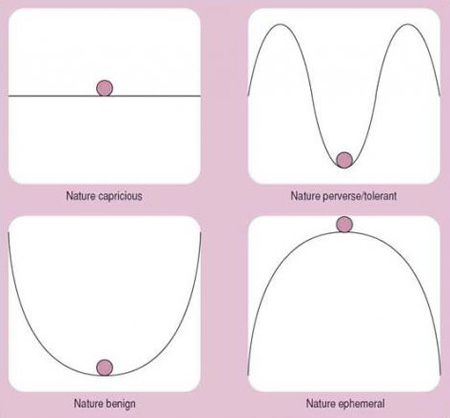6.6 The social construction of unknown risk
While some risks can be quantified, many are unknown. In the face of such uncertainty our approach to risk depends on fundamental assumptions about the way the world works which cannot be readily subject to empirical test. Different social groups have different approaches to uncertainty. Schwarz and Thompson (1990) characterise these in terms of what they describe as four myths of nature. Adams (1995) has conceptualised these in terms of a ball on a surface (see Figure 3). Imagine a ball on a surface. A small push on the ball has different effects depending on the shape of the surface.
Those subscribing to the myth of nature as capricious see the world as essentially unpredictable. A small action could have entirely unpredictable consequences of unknown scale. Those who see nature as benign believe strongly in equilibrium. However strong the disturbance to the world, the status quo tends to be restored. Those who subscribe to the perverse/ tolerant myth believe that, within limits, the world is predictable and tolerant of shocks to the system. However, pushing beyond those limits risks catastrophe. Those who see nature as ephemeral take a profoundly pessimistic view. Even small disturbances can lead to profound and potentially catastrophic changes. The world is fragile, precarious and equilibrium can be overturned by even small actions. For example, the different stances taken by different groups over climate change can be understood in these terms.
Each myth has consequences for how we deal with the world. While this framework has most often been applied to understanding reactions to environmental risk, and in the business world to understanding the reactions of different stakeholder groups, it is also clearly applicable to reactions to economic risk. For example, one can imagine quite different approaches to brand changes among firms subscribing to nature-benign and nature-ephemeral world views.

